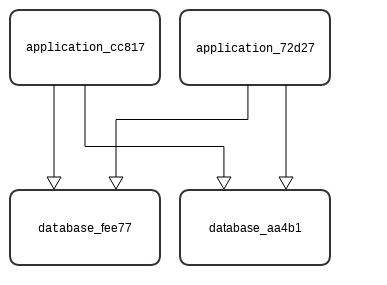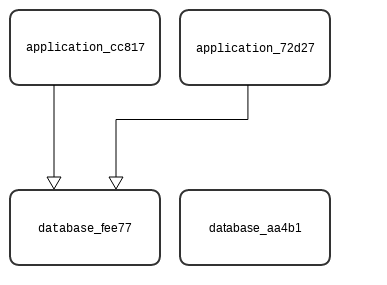Relationships
relationships enable you to define how nodes relate to one another. For example, a web_server node can be contained_in a vm node or an application node can be connected_to a database node.
Declaration
node_templates:
node:
...
relationships:
- type: ""
target: ""
properties:
connection_type: ""
source_interfaces: {}
target_interfaces: {}
...Schema
| Keyname | Required | Type | Description |
|---|---|---|---|
| type | yes | string | Either a newly-declared relationship type or one of the relationship types provided by default when importing the types.yaml file. |
| target | yes | string | The name of the node to which the current node is related. |
| connection_type | no | string | Valid values: all_to_all and all_to_one (See explanation below.) |
| source_interfaces | no | dict | A dictionary of interfaces. |
| target_interfaces | no | dict | A dictionary of interfaces. |
By default, nodes can be related using the relationship types described below. You may also declare your own relationship types.
The cloudify.relationships.depends_on Relationship Type
Describes a node that depends on another node. For example, the creation of a new subnet depends on the creation of a new network.
The cloudify.relationships.depends_on relationship type is for use as a logical representation of dependencies between nodes. You should only use it in very specific cases when the other two relationship types are not relevant, or when you want to specify that a certain node should be created before or after another for the sake of ordering.
The other two relationship types inherit from the cloudify.relationships.depends_on relationship type. The semantics of the cloudify.relationships.connected_to relationship type is the same. Therefore, usage reference should be dictated by cloudify.relationships.connected_to which is described below.
The cloudify.relationships.contained_in Relationship Type
A node is contained in another node. For example, a Web server is contained within a VM.
Example:
node_templates:
vm:
type: cloudify.nodes.Compute
capabilities:
scalable:
properties:
default_instances: 2
http_web_server:
type: cloudify.nodes.WebServer
capabilities:
scalable:
properties:
default_instances: 2
properties:
port: { get_input: webserver_port }
relationships:
- type: cloudify.relationships.contained_in
target: vm
interfaces:
cloudify.interfaces.lifecycle:
configure: scripts/configure.sh
start:
implementation: scripts/start.sh
inputs:
process:
env:
port: { get_input: webserver_port }
stop: scripts/stop.shIn the above example, the http_web_server node is contained within a vm node.
Practically, this means that:
- The
vm’s node instances are created before thehttp_web_server’s node instances. - Two instances of the
http_web_servernode will be created within each of the two node instances of thevmnode. This means that there will be 4 node instances of thehttp_web_servernode. The number of node instances for each node that is contained within another node is determined by multiplying the number of instances requested for the contained node and the actual number of instances of the node it is contained in.
To explain further:
Node ‘A’ is set to have ‘X’ node instances. Node ‘B’ is set to have ‘Y’ node instances. Node B is cloudify.relationships.contained_in node A.
Then, node ‘A’ will have X node instances and node ‘B’ will have X*Y node instances - Y node instances per node instance in ‘A’.
You may only use one cloudify.relationships.contained_in relationship per node.
Note that the implementation of cloudify.relationships.contained_in does not necessarily dictate that a node must be physically contained in another node. For instance, a counter-example to the http_web_server in a vm is an ip node that is contained in a network node. Although the IP isn’t actually contained within the network itself, if two instances of the ip node have the cloudify.relationships.contained_in relationship type with the network node, there will be two ip node instances in each instance of the network node.
The cloudify.relationships.connected_to Relationship Type
A node is connected to another node. For example, an application is connected to a database and both of them are contained in a VM.
Example:
node_templates:
application:
type: web_app
capabilities:
scalable:
properties:
default_instances: 2
relationships:
- type: cloudify.relationships.contained_in
target: vm
- type: cloudify.relationships.connected_to
target: database
database:
type: database
capabilities:
scalable:
properties:
default_instances: 1
relationships:
- type: cloudify.relationships.contained_in
target: vm
vm:
type: cloudify.nodes.Compute
capabilities:
scalable:
properties:
default_instances: 2In the above example, an application node is connected to a database node (and both the database and the application nodes are contained in a vm node.)
Since there are two vm node instances, two application node instances and one database node instance deployed, each of the VM’s will contain one database node instance and two application node instances, as explained in the cloudify.relationships.contained_in relationship type.
This actually means that there are four application node instances (two on each VM node instance) and two database node instances (one on each VM node instance). All application node instances are connected to each of the two databases residing on the two VM’s.
Multi-Instance cloudify.relationships.connected_to semantics
A specific feature in cloudify.relationships.connected_to allows you to connect a node to an arbitrary instance of another node.
Example:
node_templates:
application:
type: web_app
capabilities:
scalable:
properties:
default_instances: 2
relationships:
- type: cloudify.relationships.connected_to
target: database
properties:
connection_type: all_to_one
database:
type: database
capabilities:
scalable:
properties:
default_instances: 2In the above example there two application node instances that arbitrarily connect to one of the two database node instances.
The default configuration for connection_type is all_to_all.
The same connection_type configuration can be applied to a cloudify.relationships.contained_in relationship type, although it has virtually no effect.
connection_type: all_to_all and all_to_one
As mentioned previously, the relationship types cloudify.relationships.connected_to and cloudify.relationships.depends_on and those that derive from it have a property named connection_type for which the value can be either all_to_all or all_to_one (The default value is all_to_all).
The following diagrams make their semantics clearer.
all_to_all
Consider the following blueprint:
node_templates:
application:
type: web_app
capabilities:
scalable:
properties:
default_instances: 2
relationships:
- type: cloudify.relationships.connected_to
target: database
properties:
connection_type: all_to_all
database:
type: database
capabilities:
scalable:
properties:
default_instances: 2When deployed, there are two node instances of the application node and two node instances of the database node. All application node instances are connected to all database node instances. This would have relevance in the case of two Node.js application servers that must connect to two memcached nodes, for example.

all_to_one
Consider the following blueprint:
node_templates:
application:
type: web_app
capabilities:
scalable:
properties:
default_instances: 2
relationships:
- type: cloudify.relationships.connected_to
target: database
properties:
connection_type: all_to_one
database:
type: database
capabilities:
scalable:
properties:
default_instances: 2When deployed, there are two node instances of the application node and two node instances of the database node. All application node instances are connected to one database node instance (selected at random). This would have relevance in the case of two Node.js application servers that must add themselves as users on a single cassandra node, for example.

Relationship Instances
In the case in which you have a node with two instances and two relationships configured for them, when a deployment is created, the node instances are instantiated in the model. In the same way that node instances are instantiated for each node, relationship instances are instantiated for each relationship.
Declaring Relationship Types
You can declare your own relationship types in the relationships section in the blueprint. This is useful when you want to change the default implementation of how nodes interact.
Relationship Type Declaration
Declaring relationship types is done as follows:
relationships:
relationship1:
derived_from: ""
source_interfaces: {}
target_interfaces: {}
properties:
connection_type: ""
relationship2: {}
...Relationship Type Schema
| Keyname | Required | Type | Description |
|---|---|---|---|
| derived_from | no | string | The relationship type from which the new relationship is derived. |
| source_interfaces | no | dict | A dictionary of interfaces. |
| target_interfaces | no | dict | A dictionary of interfaces. |
| connection_type | no | string | Valid values: all_to_all and all_to_one |
Relationship Type Example
relationships:
app_connected_to_db:
derived_from: cloudify.relationships.connected_to
source_interfaces:
cloudify.interfaces.relationship_lifecycle:
postconfigure:
implementation: scripts/configure_my_connection.py
node_templates:
application:
type: web_app
capabilities:
scalable:
properties:
default_instances: 2
relationships:
- type: cloudify.relationships.contained_in
target: vm
- type: app_connected_to_db
target: databaseIn the above example, a relationship type called app_connected_to_db is created that inherits from the base cloudify.relationships.connected_to relationship type and implements a specific configuration (by running scripts/configure_my_connection.py) for the type.
Relationship Interfaces
Each relationship type (and instance) has source_interfaces and target_interfaces.
For a specific node:
source_interfacesdefines interfaces of operations that are executed on the node in which the relationship is declared.target_interfacesdefines interfaces of operations that are executed on the node that its relationship targets.
Defining interfaces source_interfaces and target_interfaces does not necessarily mean that their operations will be executed. That is, operations defined in cloudify.interfaces.relationship_lifecycle will be executed when running install/uninstall workflows. You can also add a custom relationship interface and write a custom workflow to execute operations from the new interface.
Example:
relationships:
source_connected_to_target:
derived_from: cloudify.relationships.connected_to
source_interfaces:
cloudify.interfaces.relationship_lifecycle:
postconfigure:
implementation: scripts/configure_source_node.py
target_interfaces:
cloudify.interfaces.relationship_lifecycle:
postconfigure:
implementation: scripts/configure_target_node.py
node_templates:
source_node:
type: app
relationships:
- type: source_connected_to_target
target: target_nodeIn the above example, the postconfigure lifecycle operation in the source_connected_to_target relationship type is configured once in its source_interfaces section and in the target_interfaces section. This means that the configure_source_node.py script will be executed on host instances of source_node and the configure_target_node.py will be executed on host instances of target_node. (This assumes that the plugin executor is configured as host_agent and not central_deployment_agent. Otherwise, source_interfaces operations and target_interfaces operations are all executed on the Manager.)
How Relationships Affect Node Creation
Declaring relationships affects the node creation/teardown flow in respect to the install/uninstall workflows respectively.
When declaring a relationship and using the built in install workflow, the first lifecycle operation of the source node is executed after the entire set of lifecycle operations of the target node are executed and completed.
When using the uninstall workflow, the opposite is true.
For instance, in the example, all source operations (node_instance operations, source_interfaces relationships operations and target_interfaces relationship operations) for source_node are executed after all target_node operations are completed. This removes any uncertainties about whether a node is ready to have another node connect to it or be contained in it, due to it not being available. Of course, it’s up to you to define what “ready” means.
